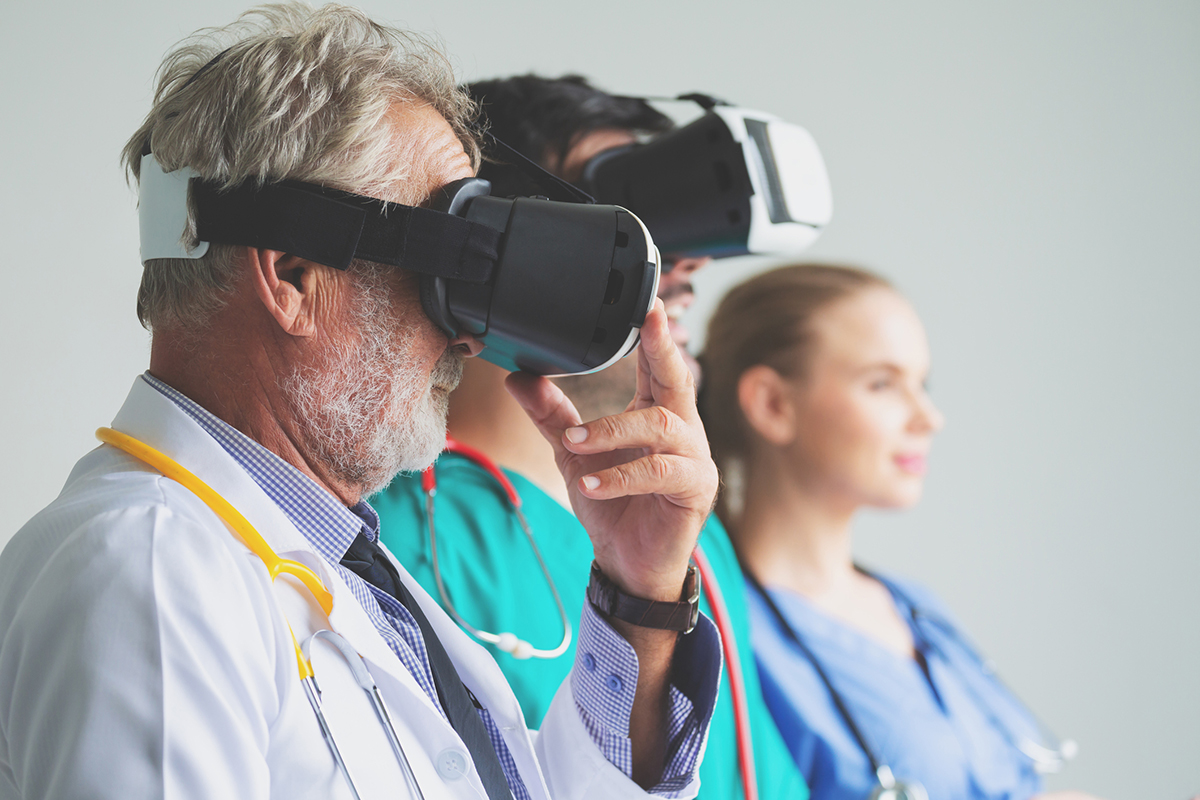Creating a More Just and Merciful World
Health science students get more out of their education through advances in simulation technology

Simulation is now widely recognized as a valuable tool for medical education, allowing students to hone their skills in a controlled environment and receive feedback from instructors and peers on their performance (StatPearls). Simulation builds on classroom learning by providing the opportunity to work on clinical and communication skills, and avoids putting real patients at risk. But simulations present a higher cost to set up and run compared to classroom learning alone.
Especially costly are simulated (or standardized) patient programs, in which people are hired to simulate symptoms and problems and be evaluated by students. This type of low-tech simulation is great for building communication and evaluation skills, but recruitment and hiring presents a high setup cost and the simulation is limited, as hired patients cannot simulate actual physiological symptoms or severe trauma.
Advances in high-tech simulation equipment are overcoming these limitations and can be much less costly, especially after initial setup. These technologies are helping to create more comprehensive health care education, more prepared professionals and better patient outcomes.
Health care innovations part 1: Computerized Mannequins
We are all familiar with the CPR training dummy, what healthcare simulation website Healthy Simulation calls a “low-fidelity” mannequin, capable of training one specific task. But mannequin simulation in healthcare has advanced leaps and bounds beyond this simple technology. “High-fidelity” mannequins use the latest computer hardware to simulate a range of conditions in a full-body “patient”. These mannequins can breathe, bleed and respond to medication. They have pulses, their vital signs can be taken, and they can be programmed to run students through a wide variety of repeatable health care scenarios, allowing for simulation work to target specific learning goals. Most importantly, these mannequins collect detailed data reports throughout the simulation, so a student can receive specific feedback in a debrief. High-fidelity mannequin tech is allowing students to safely practice an increasingly wide variety of care in a highly realistic setting.
Companies like Laerdal, whose SimMan 3G, SimMom, SimJunior and SimBaby products are used at Carlow’s Celtic Simulation Center for Innovative Learning. Laerdal manufactures mannequins which simulate different stages of life so that students can learn to care for infants, children, adults and through the full cycle of labor and childbirth. And at Boston Children’s Hospital, engineers are continually working on custom add-ons to cover more and more scenarios in pediatric mannequins, including a child with a foreign object lodged in its nose, fingernail trephination and fully-articulating limbs with “bones.”
Health care innovations part 2: Virtual Reality
VR simulations use a headset that projects an immersive field of vision to the wearer, with which they can interact freely. You may be familiar with this technology in video games and the same advances which make highly realistic VR gaming possible also have led to highly realistic virtual health care simulation.
VR has some of the same advantages as mannequins, including repeatability and detailed data-driven feedback and assessment. Companies like SimX advertise being 10% the cost of mannequin simulations while offering the ability to custom-order any number of scenarios and patients which can be programmed in weeks. The efficacy of VR in teaching complex procedures is already being demonstrated: an article published by the Royal College of Physicians explains that VR in surgical training has been shown to “decrease injury, increase speed of operations and improve overall outcomes.”
VR also is rapidly making advancements which will further expand its usefulness. Many VR systems are incorporating multiplayer technology, which will allow a team to virtually collaborate on health care simulations even from across the world. Additionally, VR is beginning to incorporate conversational patient simulation using AI; the VERA program is a VR patient which uses AI to adaptively respond to questions without any computer-like delay, allowing students to practice their medical interviewing in a repeatable, customizable program. VERA maintains eye contact and uses facial expressions to give emotional cues, allowing for the same kind of empathy training as standardized patients at a much lower cost.
Perhaps most exciting is the potential for VR to be incorporated into daily practice due to its low space and equipment requirements and enjoyable, video game-like experience.
Carlow University’s Celtic Center for Innovative Learning
Carlow University master’s in Health Science students can now reap the benefits of advanced simulation technology in the Celtic Center for Innovative Learning (CSCIL). The Center is a rich simulation lab, complete with some of the most advanced computerized mannequins on the market from Laerdal and a setting that accurately recreates a real hospital room environment down to air ventilation, computerized “patient” records, realistic medication delivery and telehealth nursing. Integrating high-tech simulation into their curriculum allows Carlow to provide culturally competent, evidence-based experiential learning to health sciences students across multiple programs.
Carlow University offers health sciences degree programs for students who are passionate about providing patient care in a variety of settings. Our programs include Pre-Physical Therapy, Pre-Speech Language Pathology, Pre-Occupational Therapy, and Pre-Physician Assistant majors—preparing students for graduate-level studies and careers in health care.
Tags: healthcare simulation technology for education, virtual reality for health science education
